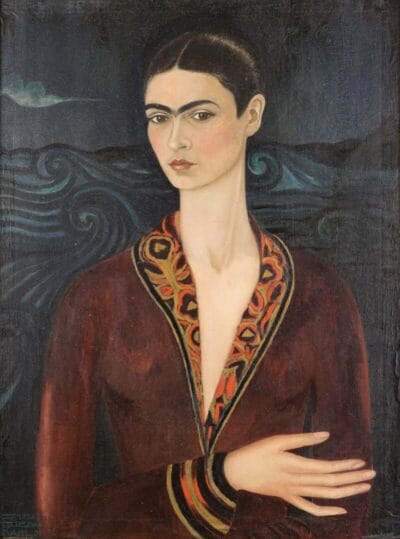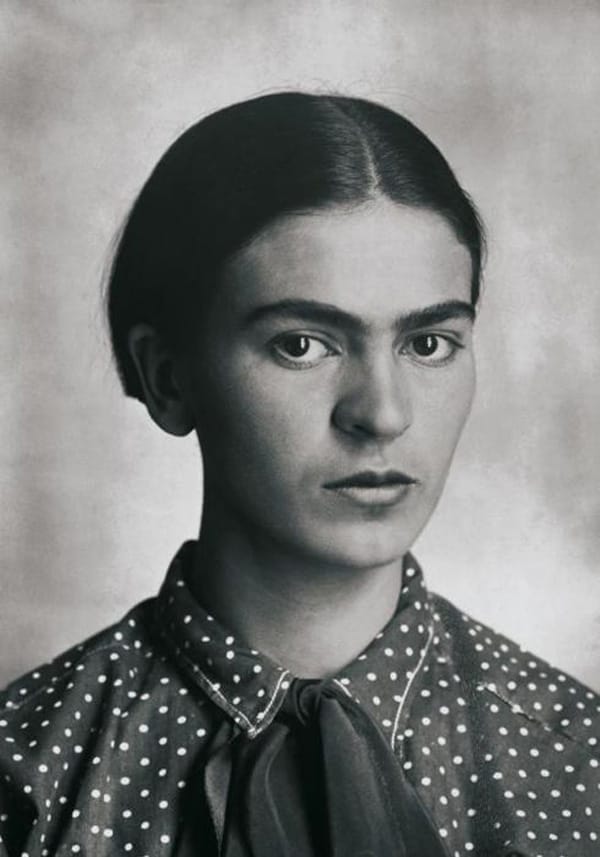Frida Khalo was a Mexican painter known for her self-portraits and bold use of color. She was born in 1907 in Coyocoan, Mexico and is considered to be one of the most influential artists of the 20th century. Khalo’s art often reflected her own personal struggles, including chronic illness and physical pain. Despite facing numerous challenges, she continued to create stunning works of art until her death in 1954. Today, Frida Khalo’s paintings are celebrated around the world and she remains an iconic figure in both the art world and feminist movement.
Early Life

Frida Kahlo was born Magdalena Carmen Frida Kahlo y Calderón on July 6, 1907 in Coyoacán, Mexico City, Mexico. She was the third of four daughters born to Wilhelm Kahlo and Matilde Calderón y González. Her father was a German photographer who had immigrated to Mexico where he met and married her mother, who was of Mexican and indigenous descent.
From a young age, Frida expressed an interest in art. Her father encouraged her artistic endeavors, giving her special boxes of coloring pencils and teaching her photography. As a child, Frida was often confined indoors while recovering from an illness, which furthered her penchant for solitary creative activities like reading, painting, collecting flowers and insects, and playing with her imaginary friends or pet animals.
The Bus Accident
In September 1925, Frida Kahlo was riding a bus in Mexico City when it collided with a streetcar. Kahlo suffered life-threatening injuries in the accident, including a broken spinal column, collarbone, ribs and pelvis, a shattered right leg, and a steel handrail that impaled her through the abdomen.
Kahlo spent over a month recovering in the hospital and underwent over 30 operations to treat her extensive injuries over her lifetime. She continued to experience complications and pain from the accident throughout her life.
The bus accident had a profound effect on Kahlo’s artistic career. During her recovery, Kahlo’s mother had a special easel made that allowed her to paint in bed. This experience ignited Kahlo’s passion for painting. Much of her later artwork depicted her injuries and chronic pain. Kahlo’s self-portraits often incorporated medical devices like corsets and prosthetics that she relied on as a result of the accident. The bus collision was a pivotal event that shaped both Kahlo’s life and artistic vision.
Marriage to Diego Rivera
Frida Kahlo first met Diego Rivera in 1922. Rivera was already a well-established artist when Kahlo asked him to critique her work. Rivera recognized Kahlo’s talent and the two soon began a relationship. Despite the age difference (Rivera was 20 years older), they married in 1929.
Kahlo was deeply in love with Rivera and viewed him as a mentor. Being married to such a famous artist bolstered Kahlo’s own fame and success. Rivera encouraged Kahlo to continue painting and even incorporated some of her work into his murals. However, the marriage was tumultuous. Rivera had numerous extra-marital affairs which caused Kahlo much anguish. Their rocky relationship was an ongoing inspiration for Kahlo’s art. Many of her self-portraits and paintings depict the emotions and pain of loving Rivera.
Overall, Kahlo’s marriage to Rivera deeply impacted her. It helped launch her into the limelight of the art world, gave inspiration for her work, but also caused her much heartache. Their passionate and troubled relationship defined much of Kahlo’s adult life.
Art Style and Themes
Frida Kahlo’s painting explored a variety of themes, often drawing inspiration from her own life and experiences. She frequently portrayed herself in surrealistic self-portraits which incorporated symbolic elements to reflect her physical and psychological pain.
Kahlo’s work was heavily influenced by indigenous Mexican culture, as seen in the bright colors and motifs that she used. She also incorporated aspects of European painting styles, such as Surrealism. Some of Kahlo’s notable paintings that exemplify her unique style include:
- Self-Portrait with Thorn Necklace and Hummingbird (1940) – This self-portrait depicts Kahlo wearing a thorn necklace that pierces her skin, with a dead hummingbird hanging down. The necklace represents the pain and suffering in her life, while the hummingbird symbolizes the lightness and fragility of life.
- The Two Fridas (1939) – A double self-portrait showing two versions of Frida sitting side-by-side, with exposed hearts and shared blood vessels. This explores her dual heritage and the idea of a fractured identity.
- The Wounded Deer (1946) – Kahlo depicted as a young deer with multiple spear-like objects protruding from her body. This represents her ongoing physical suffering and resilience.
Kahlo’s imaginative and emotionally evocative self-portraits often contained dark symbolism and surrealist elements to reflect on trauma, suffering, identity, sexuality, and mortality. Her work broke from traditional notions about the female artist and provided a deeply personal window into her inner psychological world.
Later Years
The last decade of Frida Kahlo’s life was marked by declining health and political activism. After her split from Diego Rivera in 1939, Frida underwent spinal surgery in New York but continued to suffer chronic pain and other complications from the bus accident in her youth. She was hospitalized for a year in 1950 and had to wear a series of corsets and undergo multiple surgeries on her spine and right leg, which had to be amputated below the knee due to gangrene.
Despite her physical limitations, Frida remained committed to political causes, joining the Mexican Communist Party and protesting U.S. imperialism. She helped establish the exhibition “Twenty Centuries of Mexican Art” and taught art to students at the Ministry of Public Education’s School of Painting and Sculpture. Frida also mentored young artists like Fanny Rabel and Arturo García Bustos, who lived with her at her home studio, La Casa Azul.
Though she continued painting, her output slowed due to her health struggles. She returned to more intimate subject matter and smaller canvases, influenced by Mexican folk art. Her work from this period reflects her resilience and nationalist spirit in the face of personal turmoil.
Death
Frida Kahlo died on July 13, 1954 at the age of 47. The official cause of death was pulmonary embolism, although there is speculation that she may have died from an intentional overdose.
After Kahlo’s death, Diego Rivera ordered that her home where she lived and worked, La Casa Azul (The Blue House), be turned into a museum honoring her life and work. He donated the home and its contents, including numerous works by Kahlo, a large collection of pre-Columbian artifacts and Mexican folk art, as well as works by some of her famous contemporaries.
La Casa Azul opened as a museum in 1958 and today contains a collection of nearly 300 of Kahlo’s paintings, drawings, and diaries, as well as numerous photographs and artifacts. It offers visitors the unique opportunity to view Frida Kahlo’s home and studio just as she left it, with her wheelchairs, paints, brushes, and personal belongings on display. The museum continues to honor her memory as one of Mexico’s greatest artists.
Legacy
Frida Kahlo’s legacy has only grown since her death in 1954. For many years, she was viewed primarily as the wife of famous Mexican muralist Diego Rivera. However, starting in the 1970s, a wave of feminist scholars and artists began to critically re-evaluate Kahlo’s work and life.
They highlighted how Kahlo’s intensely personal paintings conveyed female experiences and emotions often overlooked in a male-dominated art world. Kahlo’s symbolic self-portraits, open exploration of themes like intimacy, pregnancy loss, pain, and sexuality were seen as profoundly feminist statements. She became viewed as an artistic genius in her own right, known for capturing emotional truths rather than physical realism.
Kahlo also became admired as a style icon, blendingMexican indigenous culture with European avant-garde fashion. She cultivated a distinctive look featuring traditional Tehuana dresses, intricate braids and hair ornaments, and her famous unibrow.
In pop culture today, Kahlo has taken on cult figure status. Her instantly recognizable face continues to inspire art, fashion, merchandise, and imitation. She remains a feminist icon and one of the most commercially successful painters of all time. Her life story continues to fascinate the world, exemplifying creativity triumphing over adversity. While the commercialization of her image remains controversial, there’s no doubt that Kahlo’s bold spirit lives on and continues to inspire new generations.
Notable Quotes
Frida Kahlo was known for her thought-provoking quotes about art, life, and overcoming adversity. Here are some of her most inspiring quotes:
“I paint my own reality. The only thing I know is that I paint because I need to, and I paint whatever passes through my head without any other consideration.”
This quote speaks to Frida’s highly personal, introspective art that depicted her own realities and inner thoughts. She painted not for money or fame, but because it was a fundamental need for her.
“Feet, what do I need you for when I have wings to fly?”
Frida frequently incorporated imagery of wings and flight in her paintings. This poetic quote alludes to her desire to transcend physical limitations through her art.
“At the end of the day, we can endure much more than we think we can.”
Despite enduring immense physical pain and personal struggles, Frida persevered and continued to create powerful art. This quote reflects her resilience and determination.
“I never painted dreams. I painted my own reality.”
Frida was committed to depicting her true self in her paintings, rather than catering to others’ expectations. She turned her own pain and life experiences into impactful art.
“I am my own muse, I am the subject I know best. The subject I want to know better.”
Frida viewed herself as her own muse and inspiration. Her extensive self-portraits reflect her continual self-examination and desire to know herself deeply through her art.
Notable Paintings
Frida Kahlo produced hundreds of paintings over the course of her life. Here are some of her most famous works:
- Frieda and Diego Rivera (1931) – This double portrait depicts Kahlo and her husband Rivera. She portrays herself in native Mexican clothing with a loved, yet troubled expression, while Rivera appears in a boxy suit and calm demeanor.
- Henry Ford Hospital (1932) – This stark painting conveys Kahlo’s emotional and physical pain after a miscarriage and induced abortion. She depicts herself naked and bleeding on a hospital bed, surrounded by symbolic objects.
- The Two Fridas (1939) – Perhaps Kahlo’s most famous painting, this Surrealist-style portrait shows two identical versions of herself holding hands. One Frida is dressed in modern European attire, while the other wears traditional Mexican dress, suggesting her two cultural identities.
- Self-Portrait with Thorn Necklace and Hummingbird (1940) – Kahlo painted herself with a necklace of thorns and a dead hummingbird on her throat, representing both the physical pain she endured and the lightness of spirit she tried to maintain.
- The Wounded Deer (1946) – In this symbolic self-portrait, Kahlo depicts herself as a young stag with multiple arrow-like wounds, which reflect her ongoing health problems. A crutch serves as the deer’s remaining leg, alluding to her own amputated leg.
Further Reading
Frida Kahlo is such an iconic and fascinating figure that has been the subject of numerous books, films, and other works. Here are some recommendations for those looking to learn more about her life and art:
- Frida: A Biography of Frida Kahlo by Hayden Herrera – This biography is considered the definitive work on Kahlo’s life. Herrera paints a rich portrait of Kahlo’s childhood, artistic development, complex marriage to Diego Rivera, politics, friendships, and more.
- Frida Kahlo: The Paintings by Hayden Herrera – A beautifully illustrated book focusing specifically on an in-depth analysis of Kahlo’s works. Herrera breaks down the meaning, influences, and major themes behind Kahlo’s major paintings.
- Frida directed by Julie Taymor – This biopic dramatizes Kahlo’s life from her childhood and accident to her tumultuous relationship with Rivera. Salma Hayek received an Oscar nomination for her acclaimed portrayal of the artist.
